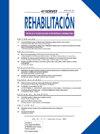唐氏综合症儿童张力低下分级:一项心理测量学研究
IF 0.4
Q3 Medicine
引用次数: 0
摘要
目前,张力过低是通过观察来诊断和分级的。本研究旨在开发一个有效和可靠的量表来评估唐氏综合症儿童张力低下。材料与方法创建了一个43项的初始量表来测量唐氏综合征儿童的张力低下。在对结果进行心理测量分析后,消除了21个项目,产生了22个项目的量表,应用于50名7至94个月大的儿童(28名女孩)的样本。用α系数和ICC系数对项目分析、内部一致性、评价者间一致性和重测信度进行分析。假设检验通过方差分析和学生t检验计算,标准效度通过与专家评估者观察到的临床感觉进行比较。结果22项量表报告了其测量的高可靠性,稳定性和可重复性,无论是整体还是单个。评价间一致性较高[0.88-1.00],内部一致性较高。根据性别或运动阶段没有发现显著差异。此外,根据临床感觉的程度和张力低下的程度也有显著差异。结论该量表能较好地评价肌张力过低,是一种可靠、有效的量表。本文章由计算机程序翻译,如有差异,请以英文原文为准。
Grading hypotonia in children with Down syndrome: A study psychometric
Introduction and objectives
Currently, hypotonia is diagnosed and graded observationally. This study aimed to develop a valid and reliable scale for assessing hypotonia in children with Down syndrome.
Material and method
An initial 43-item scale was created to measure hypotonia in children with Down syndrome. After psychometric analysis of the results, 21 items were eliminated, resulting in a 22-item scale that was applied to a sample of 50 children (28 girls) between 7 and 94 months. The item analysis, internal consistency, inter-rater agreement, and test–retest reliability with alpha and ICC coefficients were analyzed. Hypothesis testing was calculated by ANOVA and Student's t-tests, and criterion validity by comparison with the clinical sensation observed by an expert evaluator.
Results
The 22-item scale reported high reliability, stability, and reproducibility of its measures, both globally and individually. Inter-rater agreement was high [0.88–1.00] and internal consistency was higher. No significant differences were found according to sex or motor stage. Furthermore, significant differences were found according to the clinical sensation of the rater and grade of hypotonia.
Conclusions
The developed scale allows to assess hypotonia and proved to be reliable and valid.
求助全文
通过发布文献求助,成功后即可免费获取论文全文。
去求助
来源期刊

Rehabilitacion
Medicine-Rehabilitation
CiteScore
0.80
自引率
0.00%
发文量
63
期刊介绍:
La revista que es desde hace más de 40 años la publicación oficial de la Sociedad Española de Rehabilitación y referente de la mayoría de las Sociedades de la Especialidad de los países americanos de habla hispana. Se publican 5 números pluritemáticos al año y uno monográfico sobre un tema del mayor interés y actualidad designado por el consejo de redacción.
 求助内容:
求助内容: 应助结果提醒方式:
应助结果提醒方式:


